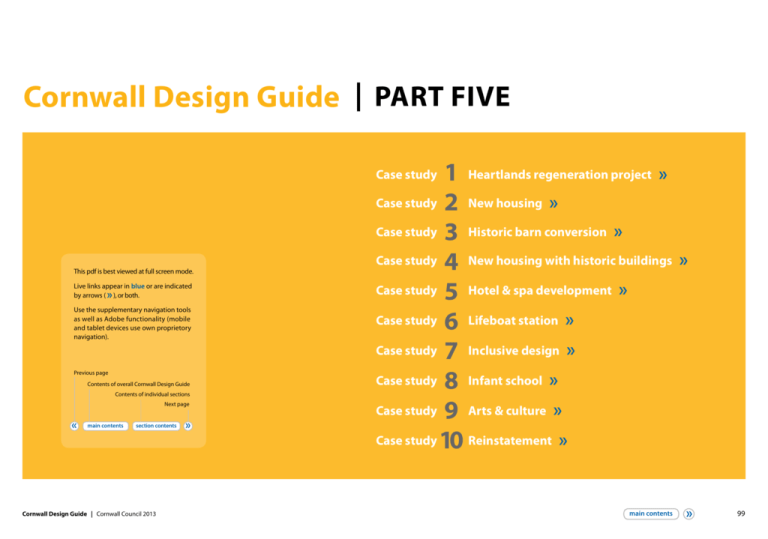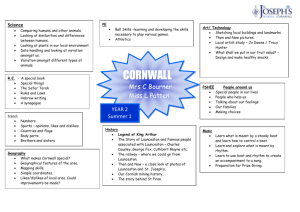Cornwall Design Guide | PART FIVE
advertisement

Case studies Cornwall Design Guide | PART FIVE 1 Heartlands regeneration project » Case study 2 New housing » Case study 3 Historic barn conversion » Case study 4 New housing with historic buildings » Case study 5 Hotel & spa development » Case study 6 Lifeboat station » Case study 7 Inclusive design » Case study 8 Infant school » Case study 9 Arts & culture » Case study10 Reinstatement » Case study This pdf is best viewed at full screen mode. Live links appear in blue or are indicated by arrows ( ), or both. » Use the supplementary navigation tools as well as Adobe functionality (mobile and tablet devices use own proprietory navigation). Previous page Contents of overall Cornwall Design Guide Contents of individual sections Next page « main contents section contents » Cornwall Design Guide | Cornwall Council 2013 main contents » 99 © imijstudio / CTD CORNWALL Cornwall Design Guide – Case Studies | Cornwall Council 2013 Cornwall Design Guide Case Studies « section contents » 100 1 © Ward Williams Associates Regeneration The old engine house at the centre of the Heartlands Regeneration project. Cornwall Design Guide – Case Studies | Cornwall Council 2013 « section contents » 101 Category: Regeneration © Ward Williams Associates © Ward Williams Associatess © Ward Williams Associates Project name: Heartlands Exhibition Building & Visitor Centre Built: 2012 Contextual information: Sustainability features: The derelict existing Grade II* Listed building has been refurbished as an Exhibition and Visitor Centre for the World Heritage Site at Heartlands. BREEAM Excellent. The new entrance area is designed to mimic the previous Listed structure that was destroyed by fire. Regeneration of derelict contaminated brownfield site to provide new economic growth and community facility. Low Energy Lighting. Lime repointing and limewash. Type of build: The materials palette is as existing or to suit the heritage of the site. Retained existing building. The building has background radiant heating using biomass heat source and district heating system. Quality design features: Utilises electric produced by the on-site PV arrays and wind turbine. New exhibition within refurbished heritage building. Decontamination of site. All areas are free to enter and so encourage community use. Fully inclusive design principles for all areas. A particular challenge in a Listed II* industrial building to be fully accessible. The engine house could not be accessed and so an armchair experience has been included in the exhibition design for this area. Collaborative working & evaluation: A full-time community liaison officer was employed on the project to ensure that the community input was ensured throughout. Architects: Heartlands » Cornwall Design Guide – Case Studies | Cornwall Council 2013 Ward Williams Associates » « section contents » 102 2 © Mitchell Architects New housing New housing for local residents, some for the disabled. Cornwall Design Guide – Case Studies | Cornwall Council 2013 « section contents » 103 Category: New housing Project name: Passivhouse – St Ive, near Liskeard Built: 2012 Quality design features: tightness target requires care to be taken on site. Post occupancy user evaluation: Passivhaus standards require an extremely airtight, super insulated building with carefully positioned glazing. Mechanical ventilation with heat recovery provides all the fresh air required. The Passivhaus standard is robust, and results in exemplary occupant comfort, and space heating requirements 75% lower than UK standard practice. All the units are being metered for two years by the University of Plymouth and the results will be analysed and presented in due course. In addition to this a whole house heat loss test has been carried out which proved that the building once constructed performed as well as the predicted performance at design stage. © Mitchell Architects Sustainability features: Ford Close is a fully certified Passivhaus development which is the first of its kind in Cornwall. The Passivhaus standard is a building fabric based solution for providing low energy homes and commercial buildings. The standard uses principles developed by the German Passivhaus Institute, based on an in-depth understanding of building physics. Buildings are designed very carefully, with close attention being paid to building fabric performance and avoiding thermal bridges. A high quality construction is essential, as the rigorous air- Passivhaustrust » Details of Collaborative working to deliver scheme: The contractor and consultants were selected well before commencement to work together to develop a scheme that would meet the Passivhaus standard in a cost effective way. There was a long process of research and development as none of the participants had delivered this standard before. A PPC 2000 Partnering Contract was used and the team continued working well on site particularly to ensure achieving the stringent air tightness requirements. Aster Homes [developer] produced an excellent home user guide which explained how to get the best out of living in a Passivhaus development. The feedback from the residents so far has been very positive and they are really pleased to be living in such comfortable, efficient homes. Architects: Mitchell Architects » Contextual information: A medium size development of 20 Passivhaus homes (12 for rent and 8 for shared ownership sale) developed in a rural location with a planning agreement restricting occupancy to local residents. There are 2 fully accessible bungalows suitable for wheelchair users. Type of build: Cornwall Design Guide – Case Studies | Cornwall Council 2013 © Mitchell Architects Traditional sub-structure construction with a beam and block floor. Timber framed construction with a rendered rain screen and a natural slate roof. Composite triple glazed windows and high performing front doors complete the envelope. It is very much a fabric first approach to construction. « section contents » 104 3 © ARCO2 Architecture Barn conversion Successful blending of the vernacular with modern design. Cornwall Design Guide – Case Studies | Cornwall Council 2013 « section contents » 105 Category: Historic conversion © ARCO2 Architecture © ARCO2 Architecture Project name: Barn conversions – Mawnan Smith Built: 2009 Contextual information: Quality design features: Sustainability features: Conversion of 4 adjoining barns and a detached barn, with later additions of oak framed glass link and traditional green oak framed garden/sun room. • Sustainable design • • Sympathetic but yet contemporary modern intervention using natural materials Green oak frame super insulated with sheep wool insulation • Air tight design • Sweeping curved sedum roof • Low energy lighting • Natural ventilation and natural light via high level clerestory glazing • Natural swimming pool • Bio-diverse sedum roofs • Passive solar design Type of build (materials etc): Green oak Sedum • Sensitive conversions of existing barns Natural Slate • Natural swimming pool Lime plaster Local Natural Stone Sheep wool insulation Cornwall Design Guide – Case Studies | Cornwall Council 2013 Collaborative working and community consultation Working closely with local craftsmen. Architects: ARCO2 Architecture » « section contents » 106 4 © Mitchell Architects New housing with historic buildings Sympathetic refurbishment of a former hospital with new development. Cornwall Design Guide – Case Studies | Cornwall Council 2013 « section contents » 107 Category: New housing with historic buildings Contextual information: Quality design features: A development of 55 extra care flats on the site of the former Passmore Edwards hospital in Liskeard. The original Passmore Edwards Hospital which was built in 1895 was retained and used as the community facilities for the development. Passmore Edwards Court is an interesting mix with the modern new build sitting alongside the traditional stone faced façade of the old hospital buildings. Type of build: A sympathetic refurbishment of the former hospital buildings with the large newbuild element constructed using blockwork with concrete plank floors. The finishes are a mix of painted render, hung slate, Marley Eternit rain screen cladding, brick and natural stone. The roof is finished in Aluminium standing seam and composite windows used throughout. Cornwall Design Guide – Case Studies | Cornwall Council 2013 The welfare of the residents was the primary focus and the internal layout was developed to reflect our previous experience of designing extra care for Aster. The aim is to promote independence through the provision of self contained flats with communal activities, care and support available when required. Sprinklers are used for fire safety but this also gives more design freedom and means fewer doors to navigate for the residents. There is mechanical ventilation with heat recovery in each flat which meant the air tightness of each flat was below 3 to ensure maximum efficiency. Sustainability features: The development was built to code for sustainable homes level 4 (although it was exempt from assessment). The building is very well insulated and combined with the MVHR means low running costs for the residents. © Mitchell Architects © Mitchell Architects © Mitchell Architects Project name: Passmore Edwards Court – Liskeard Built: 2010 process to work with the design team to deliver the best possible building within Aster’s budget. The contractor and key consultants sign the Partnering Contract and have obligations to each other under the contract and not just to the client. There was a mechanism in the contract to share any savings or cost over runs between the client and contractor to incentivise the contractor to offer efficiencies and deliver the project within the Agreed Maximum Price. Collaborative working: The scheme was procured using a PPC 2000 Partnering Contract. The contractor was identified early in the Architects: Mitchell Architects » « section contents » 108 5 © Harrison Sutton Architects Commercial development The water for the spa swimming pool is heated by a biomass boiler. Cornwall Design Guide – Case Studies | Cornwall Council 2013 « section contents » 109 Category: Commercial Project name: The Scarlet Hotel, Mawgan Porth Built: 2009 Sustainability features: A 37 bedroom hotel for adults, built to the highest eco standards, serving locally sourced food and an Ayurvedic inspired spa. • Timber used for the main building frame, • Aluminium roof, • Copper cladding, • Thrift roof membrane, • Biomass boiler fired on wood chips (waste products and FSC wood from a local company) and is used to produce hot water for bathrooms, kitchens and for heating the hotel. Type of build: Timber frame Quality design features: The Scarlet has been constructed with its potential deconstruction in mind, and can all be recycled should the hotel ever need substantial refurbishment. Post occupancy evaluation: © Harrison Sutton Partnership Contextual information: “The ability to relax anywhere. Each of the communal areas are so welcoming and homely…” Ms Garcha, 27/03/10 “Created from the heart to feed the spirit and soul; perfect break”. Tay C. 05/05/10 Architects: Harrison Sutton Partnership » Awards: 2010 International Commercial Property Awards – Winner Best Small Hotel Construction & Design (5*). 2010 Cornwall Sustainability Awards – Winner Sustainable Construction. © Harrison Sutton Partnership © Harrison Sutton Partnership 2010 South West Tourism Excellence Awards – Winner Gold Awards. 2010 Green Apple Award – Winner Leisure & Travel 2010 Michelmores/Western Morning News – Winner Project of the Year 2010 LABC – Winner Commercial Building of the Year Cornwall Design Guide – Case Studies | Cornwall Council 2013 « section contents » 110 6 © Poynton Bradbury Wynter Cole Community building The Lizard lifeboat ready for momentary call out in its new station hall. Cornwall Design Guide – Case Studies | Cornwall Council 2013 « section contents » 111 Category: Community building Project name: Lizard Lifeboat Station Built: 2011 © Poynton Bradbury Wynter Cole Contextual information: Fast Slipway Lifeboat House build on the Lizard Peninsula. Type of build: Timber Frame with structural deck, copper roof and Trespa cladding. Quality design features: Curved Glulam timber beams. Sustainability features: Water source underfloor heating system, high thermal performance. Post Occupancy Evaluation: Poynton Bradbury Wynter Cole » Cornwall Design Guide – Case Studies | Cornwall Council 2013 © Poynton Bradbury Wynter Cole Architects: © Poynton Bradbury Wynter Cole LABC South West building excellence award for best technical design. « section contents » 112 7 © Ward Williams Associates Inclusive design Light and spacy flats overlooking the winter gardens at Prince Charles House. Cornwall Design Guide – Case Studies | Cornwall Council 2013 « section contents » 113 Category: Inclusive design © Ward Williams Associates © Ward Williams Associates Project name: Prince Charles House, St. Austell Built: 2012 Contextual information: Using the latest green technology and innovative design to set new standards of accommodation for older residents, thirty eco friendly apartments were built in the heart of St Austell together with communal facilities for the wider neighbourhood. ‘brown’ roof which includes insulation and a water_ proofing system this is covered by a tiled roof finish. Quality design features: 90% of the materials from the demolition of the old Prince Charles house were re-used. Type of build (materials etc): ‘BREEAM Outstanding’ rating achieved. Prince Charles House is a highly insulated, timber frame building with rendered block walls; it has a Communal lounge creates a social space for residents but can also be hired out by the local community. Winter gardens to south facing flats. Cornwall Design Guide – Case Studies | Cornwall Council 2013 Sustainability features: Prince Charles House » The project has extremely high sustainability targets, from the design and construction of the building right through to helping residents enjoy a greener lifestyle. Prince Charles House will produce 80% less CO2 than a typical building and generate 70% of the energy it uses on site. 49kW of photo voltaics feeding landlord supply and grid; presence detection lighting in communal spaces; low energy lighting throughout; exterior charging points for electric cars; low NOX boilers. Architects: PRP Architects » « section contents » 114 8 © ARCO2 Architecture Community building The homely and cosy Lanlivery community school under a bio-diverse seedum roof. Cornwall Design Guide – Case Studies | Cornwall Council 2013 « section contents » 115 Category: Community building © ARCO2 Architecture © ARCO2 Architecture © ARCO2 Architecture Project name: Lanlivery School Built: 2004 Contextual information: Quality design features: Sustainability features: The building provides open plan flexible teaching area with a break out covered external teaching space which in 2004 was unique and has since become regarded nationally as best practice. The materials for the post and beam construction were largely sourced from FSC certified or local sources and the building boasts good levels of insulation throughout. • Sensitive design adjacent to Lanlivery church and the existing school • A statement for the school and educational sustainable learning facility for pupils & teachers • Locally sourced timber • Breathable construction • Bio-diverse sedum roof • High level clerestory glazing providing natural light and natural ventilation Awards: Recycled newspaper insulation The Cornwall Architecture Awards Other Buildings Category • • Sustainable design with touch lightly approach to construction • Post & beam construction Type of build: • Innovative & interesting design Post and beam glulam frame • Bio diverse sedum roof • High level clerestory glazing providing natural light and natural ventilation Cornwall Design Guide – Case Studies | Cornwall Council 2013 • Interactive magnetic/reflective/fire proof wall • Speedy construction • Post and beam glulam frame, minimal excavations and minimal concrete which was instrumental in providing exceptional value for money. The building has been the subject of research by the DfEE, Newcastle University and numerous other bodies and has set a bold precedent for community achievement and innovative design. International RICS Award for Sustainability Collaborative working & evaluation: Many of the fittings were reclaimed and the project was completed with the active participation of parents, staff and governors, Architects: ARCO2 Architecture » « section contents » 116 9 © Cornwall Council Arts & culture The cheerful & fun art feature enlivening a former bland spot in St Austell. Cornwall Design Guide – Case Studies | Cornwall Council 2013 « section contents » 117 Category: Arts & Culture Project name: Janet Shearer trompe l’oeil, St. Austell Built: 2008 Quality design features: © Cornwall Council A competent artist has created a feature of real interest in St Austell and the appropriate materials used have withstood the external weather conditions without damage or loss of quality. Collaborative working & evaluation: The design team worked with St Austell Civic Pride, Town Council and local councillors Contextual information: The trompe l’oeil includes a range of well known people with connections to St Austell and so provides a guessing game for observers in addition to creating a feature of visual interest at a critical viewpoint in the town. Post occupancy user evaluation: Range of positive comments from people in St Austell and lack of vandalism suggests a high level of user evaluation. The site was created by highway re-alignment resulting in an ugly gable end of buildings in a prominent position, opposite the west end of the main shopping street in St Austell, Fore Street. Town centre, wall mounted feature art. Artist: Janet Shearer Cornwall Design Guide – Case Studies | Cornwall Council 2013 » © Cornwall Council Type of build: « section contents » 118 © Artchart Architecture 10 Reinstatement The reinstated historic shop front with additional accommodation in Helston. Cornwall Design Guide – Case Studies | Cornwall Council 2013 « section contents » 119 Category: Reinstatement Project name: Olivers butchers shop & adjacent cottage, Meneage Street, Helston. Built: 2008 Before and after: Cottage (historically a shop also): Conversion and extension of cottage to form 3 apartments, replacement roof covering, replacement windows, removal of cement render & pebble dash, rebuilding of chimney, reinstatement of original dormer. Cottage: Roof coverings and rainwater goods as noted above. New windows as noted above. New ‘original feature’ slate roofed and clad dormer to street elevation. Exposing of natural stonework with new lime mortar pointing. New slate window cills. Reinstatement of original period features. Presumed to be constructed circa 18 century. The properties are not listed, however they do lie within the conservation area of the historic town of Helston. The shop had been “modernised” sometime around the 1960’s by a supermarket cooperative. The cottage / former shop had been converted to a single cottage at an unknown time but retained its shop frontage. Type of build: Traditional masonry and site cut joinery. Quality design features: Shop: To street elevation ‘wet laid’ salvaged natural scantle slates, to all other elevations ‘dry laid’ salvaged natural scantle slates. Salvaged natural slate hanging to first floor street elevation. New hardwood horizontally sliding sash windows fabricated to the Cornwall Design Guide – Case Studies | Cornwall Council 2013 Sustainability features: Re-use of salvaged natural slates and installation of timber windows, doors and shop front. © Artchart Architecture Shop: Various works including principal aspects of removal of unsympathetic 1960’s shop front, parapet wall and UPVC windows, provide replacement traditional shop front, rebuilding of chimneys, removal of cement render, replacement roof covering. Reinstatement of original period features. moulding profiles of the original windows. Cast iron rainwater goods. Traditional timber shop front with lead clad projecting fascia canopy, shop front joinery replicated along the designs of original historic shop fronts within the town. Traditional signwritten signage. Details of Collaborative working to deliver scheme Scheme jointly funded by the client and a grant by the former Kerrier District Council ‘Helston Townscape Initiative’ funding project, to encourage reinstatement of original historical features to properties within the town. Post occupancy user evaluation: Commendation Award for the repairs and reinstatement of lost historic features, in the Cornish Buildings Group annual awards scheme. Architects: Artchart Architecture » © Artchart Architecture Contextual information: « section contents 120






